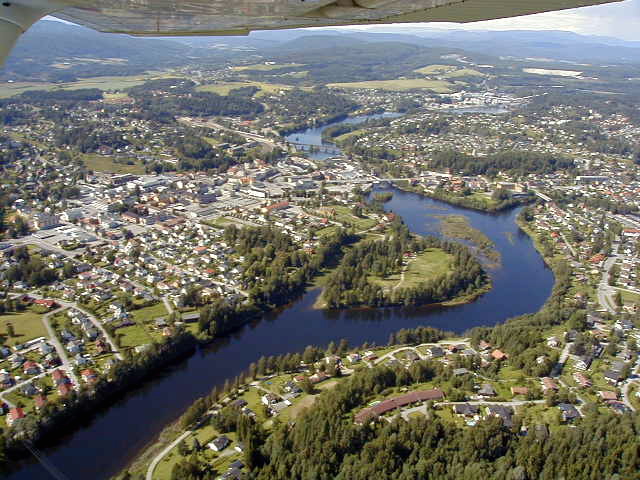|
Rhyncholepis
''Rhyncholepis'' was an extinct genus of anaspid from the Late Silurian. Fossils of species ''R. butriangula'' and ''R. parvula'' have been found in Ringerike, Norway, and Oesel, Estonia. The genus Genus (; : genera ) is a taxonomic rank above species and below family (taxonomy), family as used in the biological classification of extant taxon, living and fossil organisms as well as Virus classification#ICTV classification, viruses. In bino ... has two species, described in 1911 and 2002. Discovery ''Rhyncholepis parvula'' was discovered and originally described in 1911, and described in more detail in 1924 by Norwegian Professor Johan Kiær. In the associated monograph, Kiær describes the genus in great detail, along with several other anaspids discovered around the same time. More recently, the second discovered species (''R. butriangula'') was described by Henning Blom, Tiiu Märss, and C. Giles Miller in 2002. References Birkeniiformes Silurian jawless fish ... [...More Info...] [...Related Items...] OR: [Wikipedia] [Google] [Baidu] |
Anaspid
Anaspida ("shieldless ones") is an extinct group of jawless fish that existed from the early Silurian period to the late Devonian period. They were classically regarded as the ancestors of lampreys, but it is denied in recent phylogenetic analysis, although some analysis show these group would be at least related. Anaspids were small marine fish that lacked a heavy bony shield and paired fins, but were distinctively hypocercal. Anatomy Compared to many other ostracoderms, such as the Heterostraci and Osteostraci, anaspids did not possess a bony shield or armor, hence their name. The anaspid head and body are instead covered in an array of small, weakly mineralized scales, with a row of massive scutes running down the back, and, at least confirmed among the birkeniids, the body was covered in rows of tile-like scales made of aspidine, an acellular bony tissue. Anaspids all had prominent, laterally placed eyes with no sclerotic ring, with the gills opened as a row of holes along ... [...More Info...] [...Related Items...] OR: [Wikipedia] [Google] [Baidu] |
Silurian
The Silurian ( ) is a geologic period and system spanning 23.5 million years from the end of the Ordovician Period, at million years ago ( Mya), to the beginning of the Devonian Period, Mya. The Silurian is the third and shortest period of the Paleozoic Era, and the third of twelve periods of the Phanerozoic Eon. As with other geologic periods, the rock beds that define the period's start and end are well identified, but the exact dates are uncertain by a few million years. The base of the Silurian is set at a series of major Ordovician–Silurian extinction events when up to 60% of marine genera were wiped out. One important event in this period was the initial establishment of terrestrial life in what is known as the Silurian-Devonian Terrestrial Revolution: vascular plants emerged from more primitive land plants, dikaryan fungi started expanding and diversifying along with glomeromycotan fungi, and three groups of arthropods ( myriapods, arachnids and hexapods) ... [...More Info...] [...Related Items...] OR: [Wikipedia] [Google] [Baidu] |
Extinct
Extinction is the termination of an organism by the death of its Endling, last member. A taxon may become Functional extinction, functionally extinct before the death of its last member if it loses the capacity to Reproduction, reproduce and recover. As a species' potential Range (biology), range may be very large, determining this moment is difficult, and is usually done retrospectively. This difficulty leads to phenomena such as Lazarus taxon, Lazarus taxa, where a species presumed extinct abruptly "reappears" (typically in the Fossil, fossil record) after a period of apparent absence. Over five billion species are estimated to have died out. It is estimated that there are currently around 8.7 million species of eukaryotes globally, possibly many times more if microorganisms are included. Notable extinct animal species include Dinosaur, non-avian dinosaurs, Machairodontinae, saber-toothed cats, and mammoths. Through evolution, species arise through the process of specia ... [...More Info...] [...Related Items...] OR: [Wikipedia] [Google] [Baidu] |
Fossil
A fossil (from Classical Latin , ) is any preserved remains, impression, or trace of any once-living thing from a past geological age. Examples include bones, shells, exoskeletons, stone imprints of animals or microbes, objects preserved in amber, hair, petrified wood and DNA remnants. The totality of fossils is known as the ''fossil record''. Though the fossil record is incomplete, numerous studies have demonstrated that there is enough information available to give a good understanding of the pattern of diversification of life on Earth. In addition, the record can predict and fill gaps such as the discovery of '' Tiktaalik'' in the arctic of Canada. Paleontology includes the study of fossils: their age, method of formation, and evolutionary significance. Specimens are sometimes considered to be fossils if they are over 10,000 years old. The oldest fossils are around 3.48 billion years to 4.1 billion years old. Early edition, published online before prin ... [...More Info...] [...Related Items...] OR: [Wikipedia] [Google] [Baidu] |
Ringerike (municipality)
Ringerike is a Municipalities of Norway, municipality in Buskerud Counties of Norway, county, Norway. It is part of the Districts of Norway, traditional region of Ringerike (traditional district), Ringerike. The administrative centre of the municipality is the List of cities in Norway, town of Hønefoss. The municipality of Ringerike was created on 1 January 1964 after the merger of the town of Hønefoss and the rural municipalities of Hole, Norway, Hole, Norderhov, Tyristrand, and Ådal. However, the area of Hole was removed from the municipality of Ringerike on 1 January 1977 to become a separate municipality once again. The historic area of Ringerike included not just the modern municipality of Ringerike but also Hole and Krødsherad, Modum, and Sigdal. General information Etymology The Old Norse language, Norse form of this name was ''Hringaríki''. The first element is (probably) the genitive plural of ''hringir'', the name of an old Germanic peoples, Germanic tribe. The la ... [...More Info...] [...Related Items...] OR: [Wikipedia] [Google] [Baidu] |
Oesel
Saaremaa (; ) is the largest and most populous island in Estonia. Measuring , its population is 31,435 (as of January 2020). The main island of the West Estonian archipelago (Moonsund archipelago), it is located in the Baltic Sea, south of Hiiumaa island and northwest of the Gulf of Riga. The administrative centre of the island, and of the Saare ''maakond'' (county), is the town of Kuressaare. From the 13th century until the first half of the 20th century, the island of Saaremaa was known in most of the world by variants of its other historical name Ösel. Etymology Saaremaa was called ''Eysýsla'' in the Icelandic sagas and other early medieval Scandinavian sources (Old Norse: , meaning "the island district"), and named in contrast with ''Aðalsýsla'' ("the great district") or the Estonian mainland. The island is called in modern Estonian and in Finnish — literally "land of the isle" or "land of the island",Toomse, Liine. "10 Estonian Islands You Should Visit." http ... [...More Info...] [...Related Items...] OR: [Wikipedia] [Google] [Baidu] |
Genus
Genus (; : genera ) is a taxonomic rank above species and below family (taxonomy), family as used in the biological classification of extant taxon, living and fossil organisms as well as Virus classification#ICTV classification, viruses. In binomial nomenclature, the genus name forms the first part of the binomial species name for each species within the genus. :E.g. ''Panthera leo'' (lion) and ''Panthera onca'' (jaguar) are two species within the genus ''Panthera''. ''Panthera'' is a genus within the family Felidae. The composition of a genus is determined by taxonomy (biology), taxonomists. The standards for genus classification are not strictly codified, so different authorities often produce different classifications for genera. There are some general practices used, however, including the idea that a newly defined genus should fulfill these three criteria to be descriptively useful: # monophyly – all descendants of an ancestral taxon are grouped together (i.e. Phylogeneti ... [...More Info...] [...Related Items...] OR: [Wikipedia] [Google] [Baidu] |
Silurian Jawless Fish
The Silurian ( ) is a geologic period and system spanning 23.5 million years from the end of the Ordovician Period, at million years ago ( Mya), to the beginning of the Devonian Period, Mya. The Silurian is the third and shortest period of the Paleozoic Era, and the third of twelve periods of the Phanerozoic Eon. As with other geologic periods, the rock beds that define the period's start and end are well identified, but the exact dates are uncertain by a few million years. The base of the Silurian is set at a series of major Ordovician–Silurian extinction events when up to 60% of marine genera were wiped out. One important event in this period was the initial establishment of terrestrial life in what is known as the Silurian-Devonian Terrestrial Revolution: vascular plants emerged from more primitive land plants, dikaryan fungi started expanding and diversifying along with glomeromycotan fungi, and three groups of arthropods (myriapods, arachnids and hexapods) became full ... [...More Info...] [...Related Items...] OR: [Wikipedia] [Google] [Baidu] |
Fossils Of Norway
A fossil (from Classical Latin , ) is any preserved remains, impression, or trace of any once-living thing from a past geological age. Examples include bones, shells, exoskeletons, stone imprints of animals or microbes, objects preserved in amber, hair, petrified wood and DNA remnants. The totality of fossils is known as the ''fossil record''. Though the fossil record is incomplete, numerous studies have demonstrated that there is enough information available to give a good understanding of the pattern of diversification of life on Earth. In addition, the record can predict and fill gaps such as the discovery of ''Tiktaalik'' in the arctic of Canada. Paleontology includes the study of fossils: their age, method of formation, and evolutionary significance. Specimens are sometimes considered to be fossils if they are over 10,000 years old. The oldest fossils are around 3.48 billion years to 4.1 billion years old. Early edition, published online before print. The ob ... [...More Info...] [...Related Items...] OR: [Wikipedia] [Google] [Baidu] |






